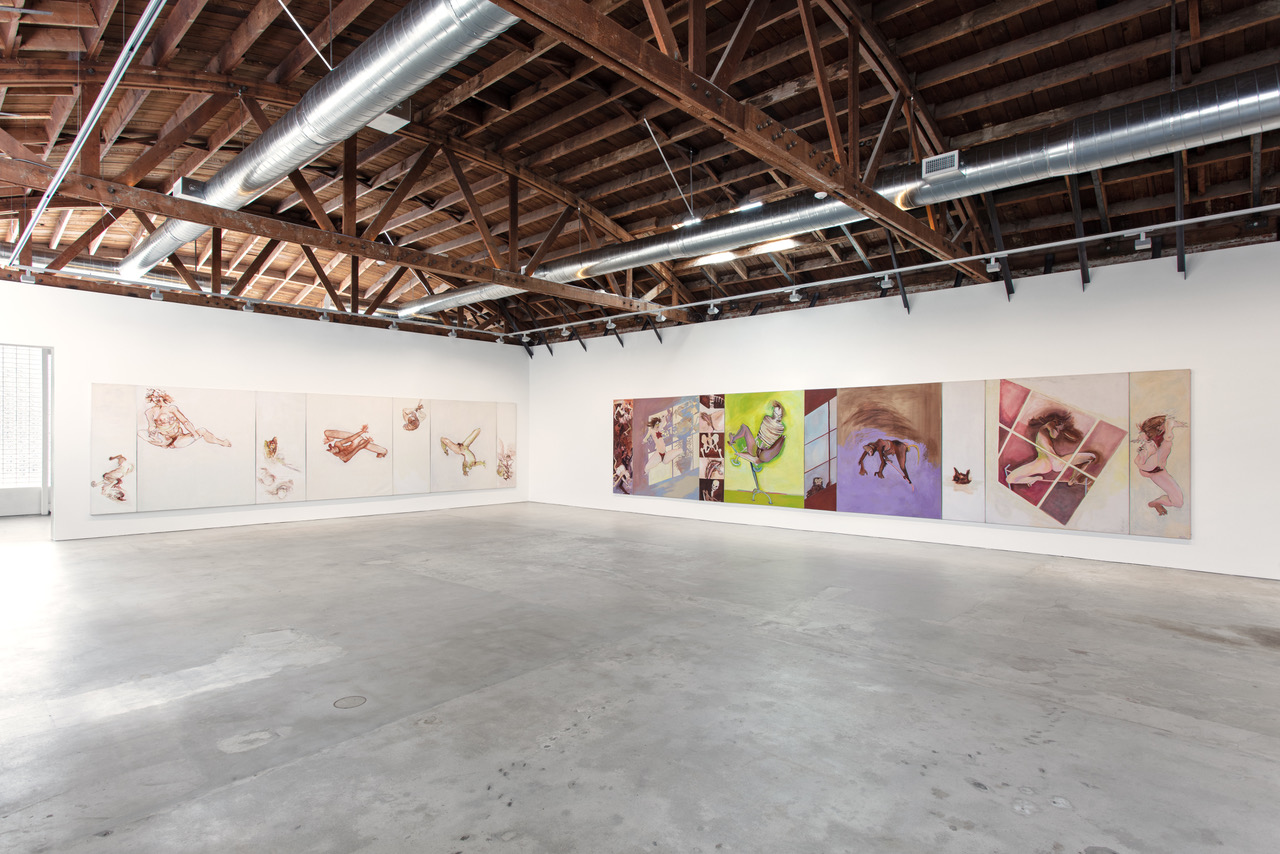 Juanita McNeely, Moving Through, 1975. Signed recto on panel no. 9. Oil on canvas, 84 x 408 inches @ James Fuentes Gallery.
Juanita McNeely, Moving Through, 1975. Signed recto on panel no. 9. Oil on canvas, 84 x 408 inches @ James Fuentes Gallery.
By LITA BARRIE October 31, 2023
Juanita McNeely’s fiercely beautiful paintings explore taboo subjects that would usually make us squirm and cringe. The power of her complex paintings is that they use the beauty of refined color, unconventional composition and physical movement to capture our attention and lure us in – much like a honey trap – to face uncomfortable truths about abortion, cancer and disability. Although figurative painting often addresses issues of identity politics, it seldom addresses the feelings of bodily pain – with the exception of Frida Kahlo. But what makes McNeely’s work resonate so deeply is that she paints because she has to paint, to triumph over her pain. Her delicate brushwork and layered color gradations counter-balance her disturbing subject matter and make her struggle beautiful. Painting is her escape where she imagines herself in flight, leaping and prancing above hurdles, transcending her prison of bodily suffering.
McNeely’s emotional honesty is disconcerting because her paintings defy the unspoken social etiquette of hiding the embarrassing physical aspects of being human. McNeely broadcasts raw emotions most people shy away from, by giving them shape through precise draftsmanship and virtuoso painting techniques. Her vulnerability is courageous and pulsates through her paintings because she depicts female bodies in the way we live inside them. McNeely is not interested in fake perfection, only the deeper psychological truth of embodied life.
McNeely’s paintings are rooted in her own experience, beginning in her first year at art college when she was hospitalized then subsequently diagnosed with cancer and given six months to live. This was followed by complications from an illegal abortion prior to Roe vs Wade, another diagnosis of cancer in 1975, and an accident that damaged her spinal cord, forcing her to use a wheelchair. Today, the 87-year old feminist painter is finally having her moment, with her major paintings simultaneously viewable across three cities in the United States. In addition to these three, multi-panel works – comprising 23 panels in total – currently on view at James Fuentes Los Angeles, her nine-panel piece Is it Real? Yes, it Is! (1969) is now part of the Whitney Museum’s permanent collection, and her four-panel Woman’s Psyche (1968) is currently on view at the Rubell Museum in Washington, D.C.
 Juanita McNeely, From the Black Space I, 1976. Signed verso. Oil on linen @ James Fuentes Gallery.
Juanita McNeely, From the Black Space I, 1976. Signed verso. Oil on linen @ James Fuentes Gallery.
From the beginning, McNeely received support and recognition from the feminist art movement when her work appeared in the First Open Show of Feminist Art (1972), an all-women exhibition organized by Marjorie Kramer. McNeely was part of several feminist artist groups, including Women Artists in Revolution and the Redstockings, and was a member of the all-women cooperative gallery, SOHO 20 Gallery, where she had a solo show in 1980. She was an early member of Fight Censorship, founded in 1973 by Anita Steckel, which was a group of women artists who explored female sexuality in their work, then educated the conservative public about erotic art and the negative effects of censorship. Although McNeely also showed extensively in the 1970s at an artist’s collective, Prince Street Gallery, her rise to fame and wide critical acclaim only began in 2020, which corrected the oversight of being somewhat overlooked in the art historical canon.
From an early age, McNeely chose her own individual path by rejecting life modeling classes, preferring to draw from memory. She carefully observed the way women moved, and drew female figures in motion because she was not interested in stiff poses. Her work has many parallels to Maria Lassnig’s body awareness paintings; much like the Austrian artist, McNeely was not interested in how a body looks, but how it feels to be inside one. Both artists explore the feelings of naked, aching bodies, exposed with all their flaws, gestures and moods.
What makes McNeely’s depictions of naked women so unique is that she presents two sides of women: the agony of being bound down in medical stirrups during gruesome hospital procedures, and the perspective of a survivor who soars above this nightmarish suffering by leaping through the air, legs wide open and arms outstretched. These two uncensored sides of herself create an emotional tension between extreme feelings. If McNeely’s indomitable spirit did not soar above such agonizing pain with lightness and even humor, it would be too overwhelming to look at her no-holds-barred paintings.
The exhibition title piece, Moving Through (1975), features skeleton and monkey imagery in the narrow vertical panels. In one of the most gruesome center images, a female body with a bandaged upper torso and face has her feet in stirrups in a medical chair, while her legs are wide open for a bold, full-frontal vaginal depiction. This is effectively counterbalanced by a graceful image of a self-determined woman jumping in the air in front of a window, legs and arms widespread, with large expanses of red (referencing blood) between her legs and breasts.
From the Black Space I (1971) and From the Black Space II (1977) are seven-panel works that alternate between narrow verticals and nearly squares. The sheer blank fields abandon conventional composition principles. Most panels have a solitary figure with exaggerated posture: either with limbs splayed wide open or pulled tightly together in a submissive crouch. The coloring of the skin varies between unnatural shades of pink, violet, pale yellow or green, which suggest radiation or dark unpleasant earth tones that look diseased.
 Installation view @ James Fuentes Gallery.
Installation view @ James Fuentes Gallery.
From the Black Space I contains the most in-your-face vaginal imagery, with female figures sitting, falling and suspended with their legs wide open in a daring gender reversal, because this dominant posture resembles the assertiveness of manspreading. In From the Black Space II, a bald-headed woman with incongruous piebald skin and amputated arms frolics above a flaming stick, while in another panel, a disturbing Medieval character with her head wrapped in bandages grapples with a green chair. In both works, horrific images are offset with panels that feature either humorous or triumphant imagery, whether that be a naked female body with a laughing monkey face, or a flying figure wielding a pick-axe and a clenched fist, signifying her battle against cancer.
McNeely creates these images with a rag and turpentine in one hand, and a color-loaded painting brush in the other to simultaneously draw and paint. To create her signature movements, she continually reconfigures brush strokes with smaller brushes. She even simultaneously works with multiple colors by holding four brushes between the gaps of her fingers. The sheer surface is created by continuously wiping off paint.
Her paintings are steeped in references to Max Beckmann and Egon Schiele, but McNeely transformed her aesthetic influences into a unique feminist perspective, one which broke compositional conventions and introduced naked figures which were no longer stationary, but seen in motion. This was not only ahead of her time six decades ago, but it is still radical today. With abortion recently criminalized again by right-wing extremists, it is important to finally see her horrifying art about an issue that was once taboo in museums and respected galleries. However, it is the equilibrium between finesse in painting techniques and the boldness of subject matter, as well as the tension between body suffering and triumph of spirit that makes her work so inspiring.
Runs September 8 through November 18, 2023. WM
This post was originally published on this site be sure to check out more of their content.







